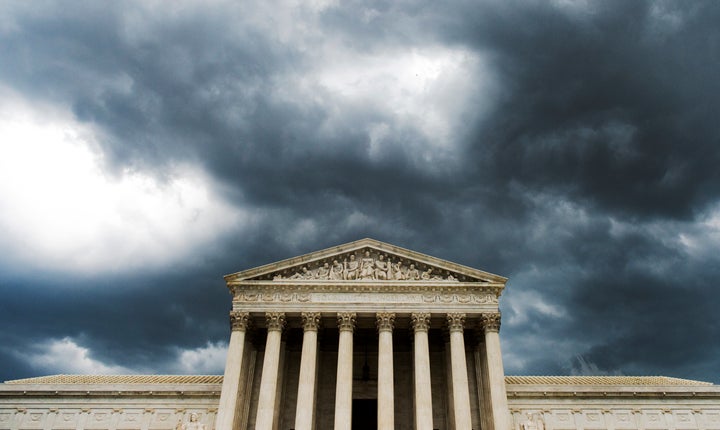For all the talk of gridlock and dysfunction in Washington, the U.S. Supreme Court stood out this year for some quality work.
It's not an overstatement to say that the liberal wing of the court logged a historic term of victories, helped in no small part by discipline and strategy behind the scenes, plus an assist by perennial swing voter Justice Anthony Kennedy.
That's not to say the court is becoming more progressive. Not at all. The institution remains deeply conservative, and some of the cases that it will be deciding in the next six months were spearheaded by legal strategists with conservative goals in mind.
Without further ado, here are the Supreme Court's high and low moments of 2015:

Gay Marriage Is Legal Everywhere
By far the biggest thing the court did in 2015 was to legalize same-sex marriage nationwide in Obergefell v. Hodges. Issued on the anniversary of other decisions expanding rights for gays and lesbians, the landmark ruling came down to a 5-4 vote, with Kennedy providing the pivotal support.
Kennedy has now written the majority opinions in all four major gay rights decisions in the history of the United States. His eloquent prose in the Obergefell decision has even been repackaged as a book, and its 28 pages were included in Longreads' best of the year.
The justice's opinion did leave some unanswered questions of constitutional law. Now the court, confronted with pending challenges in the states, may soon take up the issue of adoption by same-sex parents. Stay tuned.

The Chief Saved Obamacare ... Again
All eyes were on Chief Justice John Roberts in March, when the court heard a quirky case called King v. Burwell, the second biggest challenge to the Affordable Care Act. Roberts had already voted to uphold the law in 2012, drawing ire from conservatives, some of whom had no problem calling him a traitor.
The King case was viewed as a long shot to win -- and a lesser threat to Obamacare -- because it rested not on the limits of the Constitution, but on a singular interpretation of how the law was written. In truth, it was based on imaginary history. But the conservative challengers in the case insisted that their aim wasn't to unravel the health care exchanges and leave millions without coverage, but to simply uphold the will of Congress in drafting the law.
In the end, the chief didn't buy it. Roberts even brought Kennedy along on a 6-3 vote that ended up validating Obamacare's original goal: to make health care affordable for everyone in the country, regardless if you live in a red or a blue state.

The Justices Punted On Police Abuse
For the first time since the 2014 death of Michael Brown in Ferguson, Missouri, got the nation talking about police brutality, an officer shooting case landed on the justices' doorstep.
San Francisco v. Sheehan involved a woman with mental illness who needed help but instead was shot six times by the San Francisco police in her own apartment. She survived and later sued the officers and the police department for violating her civil rights. Her case made it all the way to the Supreme Court. There, the justices sidestepped what is becoming one of the defining issues of our time and shielded the cops from all liability.
In the Supreme Court's view, the officers had acted "reasonably" under the circumstances -- the usual legal standard when courts look at use of deadly force by law enforcement, and one of the driving factors that has helped protect the officers who shot and killed Brown, Tamir Rice and many others.
Maybe this ongoing song-and-dance was what prompted Justice Sonia Sotomayor to finally speak up in November and remind her colleagues that real lives are at stake in these cases.

Affirmative Action Drew Fire
The case hasn't even been decided yet and it's already one of the most talked about of the year. Fisher v. University of Texas at Austin, which the court heard earlier in December, is the second time the university's affirmative action program has faced strict scrutiny from the court.
Justice Antonin Scalia's outrageous suggestion at oral arguments that black students could somehow be better of at "slower-track" schools drew all the attention, but there were probing questions and answers from nearly all the justices and lawyers in the courtroom that day.
Once again, all eyes are on Kennedy, who has never voted to actually uphold an affirmative action program but in 2013 was willing to join the majority that allowed the University of Texas program to survive a little longer. The Supreme Court's own proposed 25-year deadline for the use of race as a factor in college admissions is not yet up, although that won't keep it from cutting the time short.

The Death Penalty Kept Dying, Slowly
On the final day of last term's oral arguments in the spring, the justices confronted Glossip v. Gross, a dispute over the constitutionality of Oklahoma's lethal injection protocol. By then, the justices seemed frazzled and tired, and they barely stopped short of going at each other in open court.
Ultimately, by a 5-4 vote, Oklahoma's three-drug execution cocktail was deemed constitutional by the court's conservatives. But the true story of Glossip was told by two dissenting justices: Stephen Breyer and Ruth Bader Ginsburg. Writing for both, Breyer called into question the entire capital punishment franchise, declaring it "highly likely" that, as currently practiced, the death penalty is unconstitutional.
Breyer's words resonated for months -- in Connecticut's highest court; in last-minute appeals from other inmates; even in the life of Glossip himself, who was spared death at the 11th hour due to Oklahoma's own disastrous controls. More importantly, the justice's rallying cry has energized a new generation of lawyers to attack the death penalty and maybe, once and for all, eliminate it from American justice.

The Coming Storm
In its current term, which began in October, the Supreme Court has already heard cases on workers' rights, racism in jury selection, employment discrimination and the future of "one person, one vote," among other disputes.
The justices have additionally agreed to hear high-profile cases on abortion clinics; a sort of sequel to the Hobby Lobby case, which involves employers and birth control; and the future of public sector unions. All of these will be argued and likely decided in the winter and spring of 2016.
Coupled with the very real possibility that President Barack Obama's immigration policies will get a hearing in the coming months, all signs point to a new court year as historic and controversial as the one that just ended.
The potential impact of the Supreme Court's decisions should also bring into sharper focus the true stakes of the 2016 election. In case you didn't know: The current justices are old enough that the next president could end up appointing as many as four new members to the nation's highest court.
